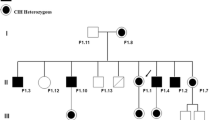Abstract
Control SV40- transformed human fibroblasts can be readily adapted to growth on medium containing galactose as sole hexose source (galactose-MEM). However, most cells from a line of SV40- transformed skin fibroblasts from a patient with galactosemia (galactose- 1- phosphate Uridylyltransferase (GALT) deficiency) died in galactose-MEM. Surviving cells of this line either grew in completely sugar-free media or had acquired significant amounts of GALT activity. Two presumptive revenant cell lines with GALT activity were characterized in detail. The expression of GALT in these two lines was stable in nonselective conditions. Each had different reaction maximum velocities with respect to uridine diphosphoglucose (UDPG) concentration as compared to residual activity in the parental cell strain or control cells. Both appeared to demonstrate heat-inactivation profiles for GALT that differed from the parental cells or controls. UDPG concentration was found to significantly alter the thermostability of GALT. A competitive radioimmunnoassay for GALT showed that these two lines had amounts of the GALT protein comparable to that of the parental cell strain or control cells. The electrophoretic mobility of GALT from the two presumptive revertants was found to differ from control cells. It was concluded that structural gene changes were probably responsible for the apparent reversion in these lines.
Similar content being viewed by others
Explore related subjects
Discover the latest articles and news from researchers in related subjects, suggested using machine learning.Literature cited
Segal, S. (1978). InThe Metabolic Basis of Inherited Disease, (eds.) Stanbury, J.B., Wyngaarden, J.B., and Fredrickson, D.S. (McGraw-Hill, New York), Ch. 8.
Tedesco, T.A., and Mellman, W.J. (1971).Science 172:727–728.
Krooth, R.S., and Weinberg, A.N. (1961).J. Exp. Med. 113:1155–1171.
Krooth, R.S., and Darlington, G.A. (1969). InGalactosemia, (ed.) Hsia, H.Y.Y. (Charles C. Thomas, Springfield), Ch. 25.
Mellman, W.J., Tedesco, T.A., Greene, A.E., and Coriell, L.L. (1975).Cytogen. Cell Genet. 15:198–199.
Slein, M.W. (1965). InMethods of Enzymatic Analysis, (ed.) Bergmeyer, H. (Academic Press, New York), pp. 117–123.
Del-Guidice, R.A., and Hopps, H.E. (1978). InMycoplasme Infection of Cell Cultures, (eds.) McGarrity, G.J., Murphy, D.G., and Nichols, W.W., (Plenum Press, New York), pp. 157–169.
Burton, K. (1956).Biochem. J. 62:315–319.
Seabright, M. (1971). A rapid banding technique for human chromosomes. Lancet2:971–972.
Ng, W.G., Bergren, W.R., and Donnell, G.N. (1967).Clin. Chim. Acta 15:489–492.
Chacko, C.M., McCrone, M.L., and Nadler, H.L. (1972).Biochim. Biophys. Acta 268:113–120.
Sparkes, M.C., Crist, M., and Sparkes, R.S. (1977).Hum. Genet. 40:93–97.
Dale, G.L., and Popjak, G. (1976).J. Biol. Chem. 251:1057–1063.
Boches, F.S. (1978). Dissertation, University of Pennsylvania.
Tedesco, T.A. (1972).J. Biol. Chem. 247:6631–6636.
Hunter, W.M., and Greenwood, F.C. (1962).Nature 194:495–496.
DiMauro, S., and Mellman, W.J. (1973).Pediat. Res. 7:745–750.
Wu, J.W., Tedesco, T.A., Kallen, R.G., and Mellman, W.J. (1974).J. Biol. Chem. 249:7038–7039.
Christopher, C.W., Colby, W.W., Ullrey, D., and Kalcker, H.M. (1977).J. Cell. Physiol. 90:387–406.
Segal, S., and Rogers, S. (1971).Biochim. Biophys. Acta 250:351–360.
Hammerson, G., Levy, H.C., Frigoletto, F., and Mandel, R. (1975).Clin. Chim. Acta 60:281–284.
Schapira, F., Gregori, C., and Banrogues, C., (1978).Biochem. Biophys. Res. Commun. 80:291–297.
Segal, S., Rogers, S., and Holtzappel, P.G. (1971).J. Clin. Invest. 50:500–506.
Zielke, H.R., Ozand, P.T., Tilden, J.T., Seudalian, D.A., and Cornblath, M. (1978).J. Cell. Physiol. 95:41–48.
Russell, J.D., and DeMars, R. (1967).Biochem. Genet. 1:11–24.
Author information
Authors and Affiliations
Additional information
This paper is dedicated to the memory of our friend, colleague, and teacher, William J. Mellman.
Rights and permissions
About this article
Cite this article
Benn, P.A., Kelley, R.I., Mellman, W.J. et al. Reversion from deficiency of galactose-1-phosphate uridylyltransferase (GALT) in an SV40-transformed human fibroblast line. Somat Cell Mol Genet 7, 667–682 (1981). https://doi.org/10.1007/BF01538756
Received:
Revised:
Issue Date:
DOI: https://doi.org/10.1007/BF01538756




